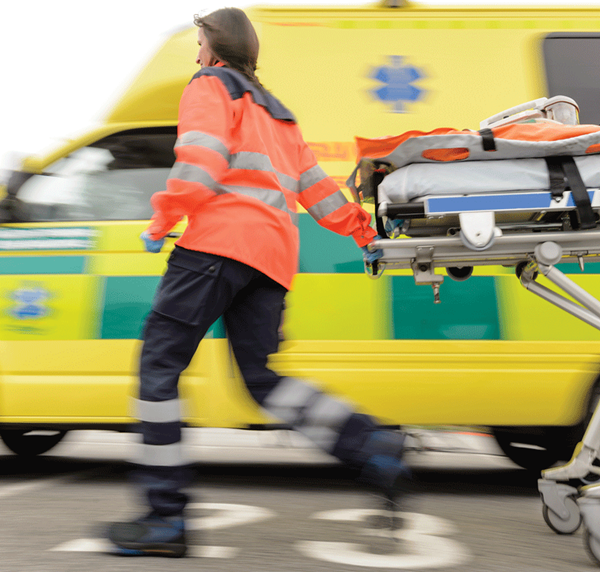“I'm scared.” The young woman was tearful. These were the words of a patient from our first call of the day, a woman from the local jail with a possible miscarriage. She had had trouble with pregnancies in the past, including a stillborn delivery that still haunted her.
The medic leaned in, talking quietly. “We'll get you to the hospital and get you checked out. Sometimes the bleeding can be normal.” She then related this to her own personal experience, saying in a reassuring voice, “When I was pregnant with my son, I had bleeding in my second trimester and it was fine. Hopefully this will be okay.”
The patient smiled. The medic finished the assessment, reported to the accepting institution, and we proceeded to deliver the patient to the ED. If it weren't for the police escort behind our truck, I would have forgotten that the patient had come from a jail.
EMS personnel are on the front lines of medicine. They are the eyes through which physicians see into the patients' homes and the circumstances of their emergencies.
I have seen many personnel in the ED treat patients from jail or police cars differently than other patients. The perception of patients can be skewed when knowledge of their personal history or the crimes they may have committed becomes known. The sincere, tender, and genuine care offered by a medic can oftentimes be compromised due to the setting. However, it is also often the case that these patients are approached, treated, and cared for as any other patient, much like the patient in this scenario.
EMS personnel on the front lines of medicine. They are the eyes through which physicians see into the patients' homes and the circumstances of their emergencies. Surrounded by medical personnel on arrival, patients often blend into the medical fray. It can be easy to forget how few people initially responded to their need, were responsible for the vital first minutes of their survival, and transported them to definitive care.
As the pre-hospital world grows in its scope, it would behoove physicians to gain a greater understanding of how pre-hospital treatment functions. Paramedics often first initiate therapy in the field – from steroids to albuterol, and from aspirin to cath lab activation for STEMI under some protocols. Pre-hospital providers work in tandem with hospital staff and physicians, and serve as a first chance for lifesaving intervention.
Residency programs vary in their education on pre-hospital care. Katzer, et al. submitted a survey regarding EMS education to all EM residency programs, of which 70% responded. They found that 89% of programs have a dedicated EMS rotation within residency.1 Rotations varied from one to nine weeks in length, with a median of three weeks. These rotations consist mainly of ground ride-along time, which can be invaluable for understanding the role of medics in pre-hospital care.
Results from the same survey indicated that most residents would like to have more disaster training added to their EMS education. Since hurricanes Katrina and Sandy, physicians' actions in disaster scenarios have been in the spotlight. As the rest of the medical system becomes more educated and prepared, ED physicians are still not required to receive disaster certification through the Department of Homeland Security. This includes training in perhaps the most important aspect of disaster preparedness – the triage system, to which many physicians are not formally introduced. This makes it more difficult for us to function as part of the disaster response system and could lead to mistakes.
When residents are incorporated into field responses, they can gain useful education in pre-hospital procedures and emergency management.2 At some training programs, residents provide radio consultation with pre-hospital providers, in addition to doing field work. These residents reported an increased sense of autonomy, ability to make medical decisions, and skills in dealing with high-acuity patients. This communication with medics in the field helps residents gain a greater understanding of the overarching management of patients from door to floor.
In my residency training program, we are fortunate to benefit from a strong EMS system in place around us. We take advantage of this through a mandatory EMS rotation, beginning discussions about mass disasters during orientation, and having a broad scope of simulation scenarios from botulinum to bombs. Like many other emergency training programs, we are taught to triage and manage resources, and as a result, our residents integrate well into the EMS system. While most EMS education comes from internal sources, we should not neglect the greatest educational resource we have – our pre-hospital providers. As it is all over the country, it is our local medics who provide an excellent education in the first frontier of medicine, stretching life-saving interventions into our patients' living rooms without compromising respect for the ones being treated. We as emergency medicine physicians should recognize the hard work they do and, if we pay closer attention, we will find that they have much to teach us.
References
- Katzer R, Cabanas JG, Martin-Gill C; SAEM Emergency Medical Services Interest Group. Emergency medical services education in emergency medicine residency programs: a national survey. Acad Emerg Med. 2012 Feb;19(2):174-9.
- Martin-Gill C, Roth RN, Mosesso VN Jr. Resident field response in an emergency medicine pre-hospital care rotation. Prehosp Emerg Care. 2010 Jul-Sep;14(3):370-6.



